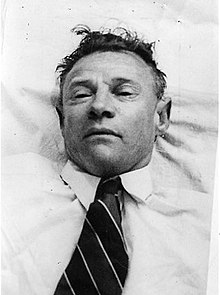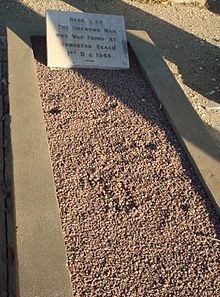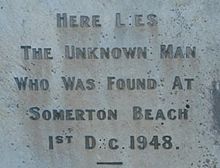Somerton man
The Somerton Man is a man (* around 1903 ; † December 1, 1948 in Adelaide ) who appeared on November 30, 1948 in the South Australian city of Adelaide on Somerton Beach and there the following morning at around 2 a.m. probably at an unknown person Poison died. Its identity and origin could never be clarified.
Since the unknown victim had a piece of paper with the words Tamam Shud on it in his pocket , the case is also known as the Tamam Shud Case (Tamam Shud case) , especially in English . The incorrect spelling of Taman Shud is also common.
Victim
The man looked European , was six feet tall, about 42 to 45 years old, weighed 88 kg and wore size 8 shoes. He was well built and in good physical condition. He had broad shoulders and narrow hips, and his torso was too big for the overall proportions. His hands were long too.
He had brown eyes. The hair was slightly gray on the temples and over the ears. He had no receding hairline , but a high forehead. The hair was blond with a slightly reddish tinge, wavy and of rather coarse substance. The haircut wasn't older than two to four weeks. At the time of his death, he was wearing a white shirt, gray-brown double-breasted suit, brown trousers, a brown sweater, brown socks and shoes - totally unsuitable for the temperature conditions in this part of Australia. The average temperatures were around 30 ° C during the day and still 22 ° C in the evening.
Upon further examination of the clothing, experts found that the items were undoubtedly American-made . This revealed the type of processing of the seams. The clothing was not imported and overall corresponded to the fashion trend of the winter season 1948 in America, where the colors gray and brown predominated. The lapels of the double-breasted suit and the pocket lining were made of orange-brown cotton sateen, which at that time was still a new material. Overall, the clothing was of high quality and indicated that the wearer was very well off financially. In general he made a well-groomed impression. His hands showed no signs of hard physical labor. Toenails and fingernails were neatly cared for. He had no calluses or calluses on his feet. However, the feet had two special features:
- The toes were pressed together like a wedge like a dancer or a person who wore long riding boots , uniform boots or other pointed footwear.
- The calf muscles showed strong expression. This is commonly found in athletes or women who have always worn high-heeled shoes.
The body, arms and legs were only slightly hairy.
Corpse discovery and autopsy
The man's body was found by a passerby named Loyd around 6:30 on the morning of December 1st. He testified that he had already seen the man on the beach at around 7 p.m. the evening before. It looked like he was smoking. A couple passed the spot between 7:30 pm and 8:00 pm. It seemed to both of them as if the man was lying drunk on the beach and sleeping. The young woman jokingly suspected that he might also be dead. Out of consideration, however, she didn't go any closer.
The autopsy revealed that the man on Somerton Beach presumably died on December 1, 1948 at around 2 a.m. The remains of a pate , an Australian or English meat pie, were found in his stomach . The dead person showed no external injuries. On the other hand, various noticeable organic findings indicated death from poisoning, as can be caused by barbiturates . However, the pate seemed to be excreted as a carrier of the substance; there were no traces of penetration by other means. The pathologist, John Dwyer, a seasoned scientist, found it impossible to detect a poison, yet he thought an unnatural death likely in his final report. Pathologists who examined the autopsy results decades later believed digoxin poisoning to be a possible cause.
On December 10th, as was customary at the time, the man's body was embalmed with formaldehyde . She was finally buried on June 14, 1949 in Adelaide in West Terrace Cemetery.
Investigations
The regional newspapers took up the topic on December 2nd and 3rd. Initially, the unknown body was assigned to a certain EC Johnson, who was 45 years old at the time the unknown man was found. However, on the afternoon of December 3, Johnson visited a police station to identify himself.
There was no evidence of the man's identity. The labels on his clothing had been carefully removed. The descriptions of his appearance, police photographs of his corpse and his fingerprints were compared with those from missing persons records in the entire English-speaking world, but could not be assigned anywhere. The fact that passers-by had not seen the man's face during his lifetime and that no one else remembered him made research difficult for the police. In 1948, neither the Australian states nor the other police stations in the world were networked with one another. The comparison of the data actually only proved that the man was not wanted or had become a criminal. How much interest was shown in this search is in any case uncertain.
In early January 1949, the unknown dead person was identified as the 63-year-old woodcutter Robert Walsh. The police were skeptical about this as they believed the body to be younger. In addition, the hands of the person found on the beach had shown no signs of physical exertion. However, investigations have been started. They were reinstated after one of the witnesses, Elizabeth Thompson, withdrew her statement from the police.
Find a suitcase
At the end of January 1949, a brown suitcase was found at Adelaide train station, which contained the same (unlabeled) items of clothing that the unknown deceased was wearing. Inside the suitcase, a certain T. Keane was said to be the owner on the name tag. In fact, a Tom Keane, a sailor living in the same region, was also missing. His relatives could not assign the missing person to the body of the man who was found on Somerton Beach.
From that point on, the police assumed that the mysterious man was traveling by train from Port Augusta , Melbourne or Sydney on November 30th, showering and shaving in the public bathing establishment and then getting a ticket for the train to Henley Beach for 10: 50 o'clock the next morning (one was found on him). He then handed in his suitcase at the train station and bought a bus ticket to Glenelg (also found on his premises).
The "Tamam Shud Trail"
In April 1949 the corpse and his clothes were found at a new, extensive study carefully rolled up, very small piece of paper on which the printed words Tamam Shud (a Persian expression that mutatis mutandis with finished or the end can be translated) stood and that had been torn from a book. It was in a small, additional pocket that had been sewn in from the inside and had previously been overlooked. The subsequent nationwide search for the corresponding book was successful. A doctor reported to local police that a book called Rubaiyat had been thrown into his car the night before the body was discovered. It is a volume of poetry by the Persian poet Omar Chayyām . The last of the poems it contains,
- And when yourself with shining foot shall pass
- Among the guests starscattered on the grass
- And in your joyous errand reach the spot
- Where I made one - turn down an empty glass!
was torn - the exact piece that the unknown man was carrying was missing.
code
On the back of the book cover there were handwritten letters that give the impression of an encrypted code:
- W (or M) RGOABABD
MLIAOI- W (or M) TBIMPANETP
- MLIABO AIAQC
- I (or V) TTMTSAMSTGAB
To this day, the rows of letters could not be deciphered . It is unclear whether the line on the paper should underline or underline the letter combination MLIAOI.
Phone number
There was also a handwritten telephone number in the book where a nurse could be reached who lived only 400 meters from where the body was found in Moseley St. Glenelg. The woman stated that she knew nothing about the dead person and the case. When asked about the title of the book, she stated that she had previously owned such a volume of poetry, but had given it to an officer in the Australian Army who had been treated in a hospital in Sydney during World War II. His name was Alfred Boxall. Since Boxall could not be found at first, the police suspected that it must be the dead person, although the woman could not identify him from her memory. Some time later, however, Boxall showed up, and he still owned the copy of the book of poetry that the woman gave him at the time. Boxall also stated that he knew nothing about the stranger.
Progress
The lack of concrete evidence led to speculation about the origin of the deceased and his cause of death, which continues to this day. In particular about the nurse and the former officer Boxall, various rumors and assumptions such as involvement in a secret service affair, a love or family drama emerged. However, they lacked concrete evidence. Both people have since passed away.
The case is still considered open by the responsible South Australian Major Crime Task Force , information is always accepted.
literature
- Ruth Balint: The Somerton Man: A Documentary Fiction in Three Dimensions. Book Chapter in Goofy History: Mistakes Make History, (Ed. Butis Butis) Böhlau Verlag, pp. 264-279, 2009.
- Ruth Balint: The Somerton Man: An unsolved history. Cultural Studies Review , Vol. 16 , no. 2, pp. 159-78, 2010.
- Thomas Erskine Cleland: Inquest into the Death of a Body Located at Somerton on 1.12.48. South Australian State Archives, GX / 0A / 0000/1016 / 0B, 1949.
- Robyn Coghlan: Connections From London to the Antipodes: The Family of John Boxall and Sarah Hugkulstone. Acme Publishing Co., Hawker, ACT, 2008. ISBN 978-0-646-50443-8 .
- Michael Newton: The Encyclopedia of Unsolved Crimes. Infobase Publishing, 2009. ISBN 0-8160-7818-1
- John Harber Phillips : Phillips' letter. (PDF; 1.9 MB) Criminal Law Journal , Vol. 18 , pp. 108-110, 1994.
- John Pinkney: Great Australian Mysteries: Unsolved, Unexplained, Unknown. Five Mile Press, Rowville, Victoria, 2003. ISBN 1-74124-024-7 .
- Klaus Schmeh : Not to be cracked - from unsolved Enigma codes to the letters of the Zodiac killer. Carl Hanser Verlag, Munich 2012, ISBN 978-3-446-43106-5 , chapter 6.
- Geoffrey Sherington: Royal North Shore Hospital, 1888-1988: A Century of Caring. Horwitz Grahame, Sydney, 1988, ISBN 0-7255-2104-X .
- Margaret Rice: The Close of an Era: A History of Nursing at the Royal North Shore Hospital, 1887-1987. St. Leonard's, NSW: Royal North Shore Hospital Graduate Nurses Association, 1988.
- Richard Walker: Curtin's Cowboys: Australia's Secret Bush Commandos. Allen & Unwin, Sydney, 1986. ISBN 0-86861-765-2 .
Web links
- Klaus Schmeh : Will an unknown dead person be identified after more than 70 years? TELEPOLIS, May 20, 2012.
| personal data | |
|---|---|
| SURNAME | Somerton man |
| BRIEF DESCRIPTION | Poison sacrifice |
| DATE OF BIRTH | around 1903 |
| DATE OF DEATH | December 1, 1948 |
| Place of death | Adelaide |



